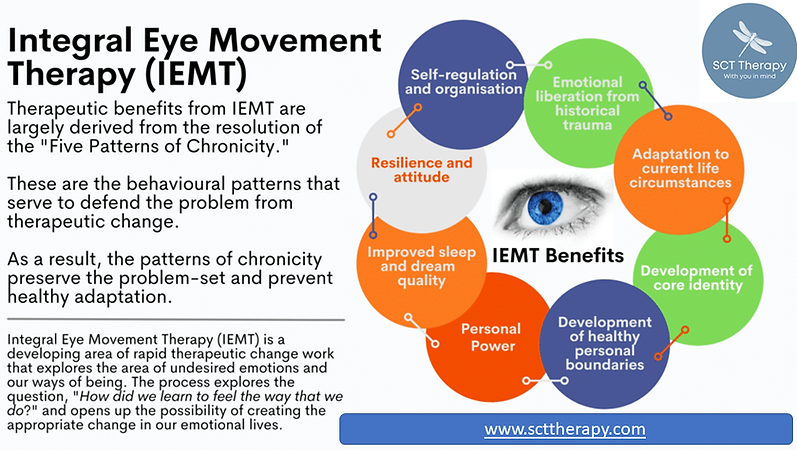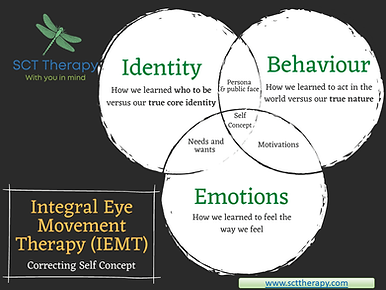
Further Information
on the approaches and techniques used
Integral Eye Movement Therapy (IEMT)
What do you know about IEMT?
Integral Eye Movement Therapy is a therapy that uses eye movements (like EMDR, but that is where the similarities end).
Although I practice both EMDR Therapy (a model used by trained professionals) and Integral Eye Movement Therapy (a model used by anyone trained in the IEMT model), this post will focus on IEMT rather than a comparison.
IEMT (developed by Andrew T. Austin, from an original idea from Steve and Connirae Andreas) is a model built around addressing and resolving The 5 Patterns of Chronicity and emotional and identity issues.
So, what is it?
IEMT is a psychotherapy model that aims to reduce intense negative emotional states. I often use it to regulate a client at the beginning of a session if they are clearly emotionally dysregulated (overwhelming stress and anxiety state).
It is an area of rapid therapeutic change work that explores the areas of undesired emotions and our ways of being. It works by exploring how a person learned to feel the way that they do and opens the possibility of creating the appropriate change needed within our emotional lives. IEMT focuses on ‘The 5 Patterns of Chronicity’ and emotional and identity imprints.
What are the Patterns of Chronicity?
These are primary identity patterns that appear common to people who are experiencing difficulties with their life, relationships, and mental health.
There are five patterns identified in IEMT:
1. Three Stage Abreaction Process - A pattern of escalating emotional behaviour to create change in the external environment.
2. The Great Big, "What if..." Question - The use of a single counterexample that sabotages and counteracts any therapeutic generalisation.
3. The Maybe Man Phenomena - The Maybe Man is uncertain of their own experience, and this reflects in their language and behaviour. By remaining uncertain and without precision they don’t commit to their genuine experience or to their identity and this inadvertently sabotages effective therapy.
4. Testing for Existence of The Problem Rather Than Testing for Change - Even when 99% improvement has been made, if the person with this pattern of chronicity is able to locate just 1% of the problem existing, they will see this as representative of 100% of the problem still existing.
5. Being "At Effect" (rather than "Being at Cause") - Being at effect means that the person perceives themselves as a victim of circumstances, where external factors are the primary cause of their life’s outcomes. By being "at effect" the person experiences emotional problems happening to them and will seek ‘treatment’ rather than seeking ‘change’. [IEMT can change this pattern to being at cause, enabling the person to take responsibility for their life and develop new belief, including the power to create the outcomes they want.]
Emotional Imprinting
Every experience causes a person to create a new kinaesthetic response (instinctive response to an external stimulus) to that experience and an Emotional Imprint is formed. This is how that person learns to feel about the experience.
Examples: At work the boss may say: “I’d like a word with you in my office”, or, we visit a hospital and see a doctor in a white coat. We may immediately feel like a child again being addressed by our parents, no matter how old we are. We may even be older than the boss or the doctor! These are examples of the Emotional Imprint in action.
IEMT asks the question, "how did this person learn to feel this way about this thing?" and resolves it.
Identity Imprinting
Identity is in a continual process of evolution, development and change. Our environment can have a huge impact on this.
Example: A shop floor worker who is promoted to management thus is no longer “one of us”, they are now “one of them - “the management”. This can create dramatic changes to status and acceptance by former workmates and new colleagues alike. So we can start asking ourselves “Who am I now?” “What does that mean to me”, “Where do I fit myself into this organisation”.
Identity issues can have deeper aspects that can feed forward into the environment and occur in many contexts. Some are more robust than others such as gender identity, identity as a father, mother, wife, husband etc.
IEMT addresses the issue of, "how did this person learn to be this way?"
Problematic issues can arise from adopting an identity and cause patterns of chronic behaviour such as: “I am a depressive”, “I am a worrier”, “I am an anxious person”. Hence this becomes imprinted and we get absorbed within this new identity. It becomes how we primarily see ourselves and present ourselves to others.
IEMT specifically addresses the identity imprint and enables the therapist to by-pass the beliefs that often support the undesired identity such as, "I cannot do that because I am a worrier or a depressive".
How does IEMT work?
IEMT:
-
Is a model built around addressing and resolving the 5 Patterns of Chronicity (“it goes where no man has gone before”).
-
Has applications in resolving PTSD and many other issues.
-
Addresses imprints of emotion for creating kinaesthetic change (relating to a person's awareness of the position and movement of the parts of the body by sensory means).
-
Addresses imprints of identity for creating change in self-concept.
-
Uses eye movement as the dominant mechanism for change.
-
Is a model that can be used, once correctly trained, with no prior qualification.
The Techy bit…
-
By design, IEMT readily creates introspection and an alpha state with free-floating imagery.
-
Traumatic imagery is largely irrelevant to the process.
The IEMT model works by the client recalling and maintaining a negative image of a difficult event that was experienced in the past. The IEMT practitioner then asks the client to move their eyes in specific directions. The typical outcome of IEMT is the reduction of negative emotions with an event or an image in mind.
There is so much more to IEMT, and to be honest I probably learned more from this technique of what makes us all tick than any other therapy, approach, or technique I’m trained in.






